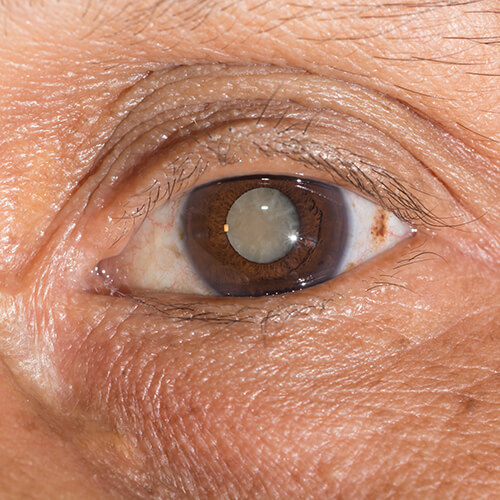Understanding Cataracts
Because cataracts are so common and because cataract surgery is my specialty, I have written this FAQ for patients to answer commonly asked questions about cataracts.
I hope that this information will help you to understand cataract better and to view potential cataract surgery with less apprehension.
Cataract FAQ
What causes blurred vision?
Just as fingerprints on a camera lens cause blurred pictures regardless of our efforts to focus, a cloudy lens within the eye causes blurred vision. When the human lens becomes cloudy or hazy enough to interfere with vision, it is called a cataract. Changing glasses will not help the blur that is caused by a cataract.
Just as defective film will spoil photographs, a weak retina or nerve (e.g., conditions such as macular degeneration, epiretinal membrane, or glaucoma) will cause blurred vision in eyes despite a clear lens and proper focus (glasses). Good vision always requires (1) optimal focus – usually with glasses, (2) a clear lens, and (3) a healthy retina and nerve.
What causes cataracts?
Some cataracts are congenital (inborn), but they can also be caused by injuries, diabetes, radiation, or prolonged use of certain medications, such as steroids. Highly nearsighted patients may develop cataracts at a younger age. However, most cataracts result simply from the natural aging process of the human lens. They do not occur at the same age or rate in everyone.
What is a “lens implant”?
To take the place of the clouded human lens, a tiny, delicately engineered artificial lens is implanted into the eye. The modern intraocular lens “implant” does not change the appearance or sensation of the eye. The implant is permanent. Unlike a contact lens, it cannot fall out. Occasionally, the membrane behind the replacement lens gets cloudy, and a quick laser procedure can be performed to polish it.
The “prescription” or power of each patient’s implant is selected based on computer calculations that use a series of precise eye measurements performed in the office prior to surgery. The distance between the front of the eye and the retina can be measured precisely using optical methods. This painless test is called biometry.
Recently, newer implant designs that can decrease your dependence upon glasses have become very popular. However, they are not appropriate for all individuals, and the additional cost is not covered by insurance.
What is “small incision” cataract surgery?
I routinely perform “small incision surgery” using specialized technology called phacoemulsification. The firm cataract core is fragmented into small particles that can be gently sucked out through a 2.5 mm incision (1/10th of an inch). Modern foldable lens implants can fit through incisions this small, and sutures are usually not required. Physical activities are not significantly restricted after small incision surgery, and the vision stabilizes faster than with the older large incision method.
What are the symptoms?
Cataracts cause visual symptoms only; they do not cause pain, discomfort, tearing, or redness. The visual symptoms can vary. Blurriness, hazy vision, or increased glare from sunlight and headlights may be present. Some cataracts turn yellow, causing fading of color. Reading may take more effort, and you may tire prematurely. Vision progressively worsens over a period of years or sometimes after only a few months.
When should cataracts be removed?
The decision to have cataracts removed is almost always elective. Because cataracts do not harm other parts of the eye, nothing needs to be done if you are not significantly bothered by symptoms. However, as activities such as driving and reading become increasingly affected by cataracts, surgery becomes a logical option to consider.
With the success of the modern implant, waiting for cataracts to “ripen” is no longer necessary. Because cataracts will not improve and will eventually worsen, there is no advantage in delaying treatment if vision is sufficiently affected and the prognosis of surgery is good. You are never “too old” to have cataract surgery, just as you are never “too old” to enjoy better vision.
How is surgery performed?
Cataract surgery is microsurgery; it utilizes an operating microscope and is performed inside the eye through an incision. One can think of the human lens as having a thin, transparent “wrapper” that holds the lens in the center of the eye. This delicate, cellophane-like skin is called the lens “capsule.” A hole is made in the front of this wrapper, and the cloudy lens is removed in several delicate stages. The implant is usually then inserted into this empty wrapper, occupying the original place of the natural lens.
What are the risks of cataract surgery?
There is some risk with any surgical procedure. For each patient, I carefully weigh the risk/benefit ratio. Fortunately, in experienced hands, severe complications that could worsen the vision are rare. The chances of eyelid, cornea, retina, and ocular pressure problems may depend on individual circumstances, but all may occur even without surgery – that is, with aging alone. With modern advances in technique, more than 98% of patients with otherwise healthy eyes will gain significant visual improvement following surgery.
What is a cataract?
A cataract is a clouding of the normally transparent lens within the eye. It is not a growth or a film that can be peeled off. Located inside the eye, most cataracts cannot be seen without a special microscope. Thus, they do not change the appearance of the eye; they do not cause discomfort. Changes may be so gradual that you are not aware of a cataract’s effect at first.
Cataracts are the most common cause of blurred vision over the age of 50. Although there is no medicine or diet to cure cataracts, surgical removal of the cataract and replacement with a permanent artificial lens implant can restore lost vision.
How does the eye work?
The eye functions very much like a camera. Light enters through the cornea, the clear front “window” of the eye. In order to reach the back of the eye, it passes through the pupil, which is the hole in the iris (the colored part of the eye).
Immediately behind the pupil is the natural lens of the eye. Just as a camera lens focuses light onto film at the back of the camera, the human lens focuses light onto the retina, the thin layer of tissue lining the back of the eye. Like camera film, the retina forms the picture that is then relayed to the brain along the optic nerve.
Cataract Surgery
Your outpatient surgery will usually be performed at the Peninsula Eye Surgery Center, 1128 W. El Camino Real, in Mountain View, CA, (650) 964-3200. This was the first surgery center from San Francisco to San Jose to specialize in eye surgery only and performs one of the highest volumes of cataract surgery in Northern California.
I generally employ topical or “needle-free” anesthesia for cataract surgery. The eye is numbed by anesthetic drops. Thanks to light sedation, you will feel calm and relaxed but be awake enough to cooperate. Since your lids are gently held open, you will see light but not the operation itself. This advanced method eliminates sutures, anesthetic injections, eye bandages, and postoperative restrictions for most patients. An additional numbing injection can be performed if you need it for your comfort. Because the surgery usually takes less than 30 minutes, even patients in poor health can successfully undergo cataract surgery.

Eye with mature cataract

Surgery Recovery
You will receive detailed written instructions on care after the operation. An eye bandage is not necessary when topical anesthesia is used. The eye surface may feel scratchy at first. With small incision surgery, you may resume everyday activities and physical exercise within one week.
As with any surgery, the healing period will vary with each individual. Use of the eye is not harmful, but the
vision is normally blurry at first. Your eyeglass prescription will be different after surgery and will be changed approximately one month later.
Helping patients regain vision they have lost is one of my most gratifying experiences. Thanks to the many advances in ocular microsurgery, we can safely restore excellent vision to most people with cataracts. About 3 million Americans enjoy the benefits of renewed sight through cataract surgery annually. I hope this material has been both interesting and reassuring to you. If you should have any further questions, please ask. Please contact us today!
